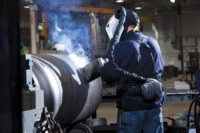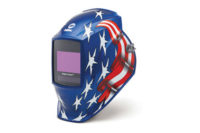Roughly 400,000 individuals are employed as full-time welders in the U.S. and millions more conduct welding, cutting, soldering and brazing operations part-time or occasionally. Welding-related operations are carried out broadly across industries and applications from manufacturing and construction, to oil and gas, and maintenance and repair.
Wherever welding is conducted workers face inherent risks: exposure to intense radiation, hot metal, electric shock, noxious fumes and loud noise. Furthermore, the environments in which welding is conducted pose additional hazards ranging from high heat, slick or frozen conditions and confined spaces, to moving and stationary heavy equipment. There is no question that wherever welding operations take place, hazards abound.
National safety standards are in place to protect workers, and it is every employer’s responsibility to ensure that OSHA 1910.252 welding regulations are met at a minimum. Yet despite regulations, welders face higher incident rates than most other industries. Injuries range from second- and third-degree burns to photokeratitis (welder’s flash) and permanent blindness. In fact, more than half of all welding incidents affect the eyes and face. Their cost to U.S. businesses is staggering and the impact to affected individuals can also be devastating, incurring diminished quality of life and capacity to earn a living.
According to the American Welding Society, leading causes of injuries include workers not wearing protective equipment even despite its availability, and workers wearing inadequate protective devices for their needs. The good news is, many welding injuries can be prevented through the proper use of personal protective equipment. When you consider the cost of an incident versus the cost of providing effective protection, it’s easy to see that selecting a quality welding helmet is well worth the investment.
Manufacturers with a long history of delivering reliable welding helmets conduct ongoing research and development to identify ways to improve every aspect of a helmet’s performance. From advanced shell materials and filter innovations, to streamlined designs and modern styling, there are many factors to consider when selecting a helmet. This article provides tips to ensure that the helmet you choose stands up to your application’s unique demands — and works as hard as your welders.
Select a suitable shell material
Welding operations are commonly conducted in high-heat applications. For workers in hot environments such as foundries, furnaces or steel and paper mills - or those frequently conducting overhead welds - be sure the helmet’s shell material is designed to withstand the highest potential temperatures. Material such as standard nylon should be avoided, as it may pose melting or burning risks. Instead, consider high-performance shell materials such as those with a fiberglass base or heavy-duty thermo plastic, which are tested and proven to resist deformation or melt-through from high heat and splatter as well as penetration from objects.
Likewise, in applications where chemical hazards exist, shell material must be suited to withstand exposure to the specific chemicals present without the risk of degradation. If you’re not sure whether a particular caustic will affect the shell, check with the manufacturer safety data sheet or with the manufacturer directly.
Choose a size and shape that supports function
Once you’ve selected a shell material, consider the helmet’s size and shape. A wide variety of styles is available and safety standards generally do not regulate helmet size. Helmets are selected, for the most part, based on user preference. The most important requirement is to ensure the helmet covers the welder from the neck up to prohibit any direct exposure to the arc. Effectively shielding the welder prevents burns to the skin from sparks, spatter and heat — and limits exposure to harmful cancer-causing rays.
Conduct a visual inspection to ensure the helmet provides adequate coverage from the wearer’s throat to above the forehead, and that it covers the ears as well. Should you find areas of exposed skin, try adjusting the headgear. If adjustments don’t completely eliminate the gaps, a larger helmet may be necessary.
In confined space applications, such as pipefitting, a smaller circumference, low-profile welding helmet design may be warranted to allow for comfortable movement and an effective viewing angle. Conversely, when welding with metals and gasses that require the use of a respirator, a larger helmet will likely be needed to allow ample space for the respirator to fit underneath. In every application, be sure the welding helmet never leaves any skin exposed to the arc.
Look to larger windows for improved productivity
The welding helmet’s most obvious function is to limit the wearer’s exposure to harmful infrared and ultraviolet rays that can cause short-term and long-term eye injuries. Whether passive or auto-darkening, if the welding helmet’s window is too small, workers will struggle to achieve a safe, clear view of the area being welded – as well as nearby hazards. They’ll also be more likely to have to work in awkward angles or change positions frequently, impacting productivity.
Modern helmets offer larger-than-ever windows to help workers conduct tasks in safe, comfortable positions and achieve a more comprehensive view of the weld and surrounding area. Look for passive windows in sizes reaching 24 square inches and ADF windows as large as 9 square inches to provide increased visibility and to support productivity. And remember, because welding helmets are a secondary form of PPE, safety eyewear must always be worn in tandem to ensure proper eye protection.
Ensure protection with proven quality
Innovations in welding helmets abound – yet it isn’t uncommon for workers to wear decade-old helmets. Now is the perfect time to invest in advanced materials, new styles, and larger windows. Be aware, however, not to choose a helmet based on good looks alone. Not all welding helmets are created equal, and careful consideration should be given to protection and performance above all else. Look for manufacturers with a proven record for delivering high quality helmets, shells and filters; review performance measurement data; and consider products with a two-year warranty to eliminate hassles if any problems should arise.
Welding tasks are widespread across industries, and those who conduct them face myriad occupational hazards. By providing workers with helmets that not only meet ANSI standards for protection, but also deliver exceptional performance and quality, employers can reduce recordables and improve safety and productivity. Every good weld begins with a well-protected individual, which is undeniably an employer’s most valuable asset.



